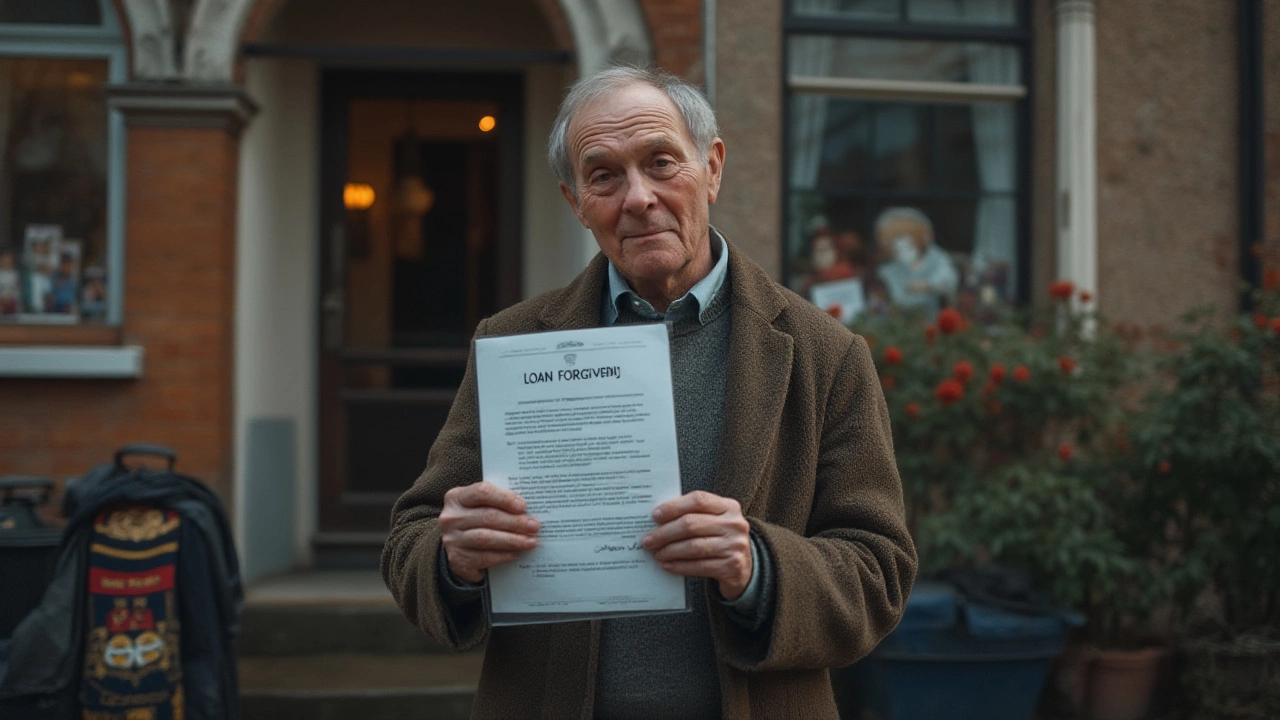Do Student Loans Get Forgiven After 25 Years? Your Guide to Long-Term Student Loan Relief
 Jul, 23 2025
Jul, 23 2025
Picture this: you’re in your early twenties, starry-eyed about the future, clutching your university acceptance letter. Fast-forward a decade or two, and the reality check smacks you right in the bank account. Monthly student loan payments don’t just sap your paycheck—they twist around your dreams, your savings, and your ability to live freely. So, does the government eventually just forgive your loans after 25 years? Is there a magic date you’re free at last, or is that story mostly wishful thinking? Let’s get real: the truth is bendy, laced with government acronyms, legal details, and exceptions that sneak up on you. If your monthly loan autopilot withdrawals have you daydreaming of getting out from under, you’re in the right place.
It’s tempting to believe student loans vanish after a set stint—that you just wait it out and the government says, "Hey, congrats, you’ve done your time." Some people hear about forgiveness programs and imagine a built-in eraser. The reality, though? Whether loans get wiped out after 25 years comes down to where you live, what loans you have, and what steps you actually take along the way. In Canada, the U.S., and beyond, the answer’s not always easy. Still, understanding what’s going on behind those ominous loan statements just might help you chart a smarter path to zero debt.
How the 25-Year Student Loan Forgiveness Rule Actually Works
First, the term you’re looking for is "forgiveness"—and it’s not as automatic or simple as it sounds. In both Canadian and U.S. systems, there’s chatter (often confusing) about loans being forgiven after 25 years. Let’s clear that up.
For Canadian federal student loans, there’s no broad, one-size-fits-all rule that says your loan simply disappears after 25 years. But there are a handful of programs that offer partial or full relief—if you fit the criteria and follow the process. The main thing to focus on: Repayment Assistance Plan (RAP). Launched in 2009, RAP helps struggling grads keep payments manageable, or even skip payments entirely depending on income. If you stay enrolled in RAP, make required payments (or qualify for $0 payments, which counts), and reach 15 years (10 years if you have a permanent disability), the remaining loan balance will be forgiven. Interesting, right? Canada doesn’t use the 25-year cut-off anymore; the government quietly shortened it in 2022, so keep that in mind.
Now, the U.S. story gets even messier. American federal student loans can be forgiven under certain income-driven repayment (IDR) plans, which generally stretch over 20 or 25 years. These plans—like Income-Based Repayment (IBR), Pay As You Earn (PAYE), Revised Pay As You Earn (REPAYE), and Income-Contingent Repayment (ICR)—promise forgiveness of your remaining balance after two or two-and-a-half decades of qualifying payments. In 2024, the U.S. Department of Education made headlines by rolling out temporary waivers to credit previous months toward forgiveness, even if you didn’t enroll in an IDR plan the whole time. But be careful: ‘qualifying payments’ is a technical term. Miss deadlines, go into default, or don’t recertify your income, and suddenly your loan clock resets.
There’s another sticking point—the kind of loans you have. Private student loans? Sorry, those don’t come with government forgiveness, in Canada or the U.S. Only government-issued or government-backed loans play in this forgiveness league. That’s why it’s so key to check which loans you hold and how they’re serviced. Some provinces (like Ontario and British Columbia) offer grace periods or partial relief, but not blanket wipeouts. And, as always, forgiveness programs change. What’s true in 2025 might shift next term, so stay plugged in if you’re a long-haul borrower.
If you dig into the official numbers, you realize how few borrowers actually get to the finish line. For example, U.S. Department of Education data from 2023 showed less than 10 percent of borrowers who started out on income-driven plans stayed in for the full 20 or 25 years. Life, jobs, moving countries—stuff happens. But if you’re disciplined and stubborn about keeping current, the programs do work. It’s not a myth; it’s just a slow-motion game.

What Steps to Take If You’re Aiming for Forgiveness
Here’s where people slip up—thinking the clock’s ticking automatically for them. If you’re hoping your student loans will one day fizzle out, you absolutely need to understand what qualifies as ‘good behavior’ in the government’s eyes.
If you’re in Canada and struggling every month, apply for the Repayment Assistance Plan immediately. You can do it online for both federal and participating provincial loans. You’ll submit income documents every six months; make sure not to skip recertification or you’ll get booted out. Every month you’re in RAP, even if you pay $0 because your income is low or non-existent, counts toward the 15-year forgiveness window. If you get a new job and your salary jumps up, your payments will too—but at no point should loan payments force you beneath a reasonable living threshold. The government actually calculates this based on family size and living costs. Student loans in Canada don’t rack up interest on the federal portion anymore (since April 2023), so it’s easier to stay afloat even when it feels like you’re treading water.
For Americans, the big move is switching to an income-driven repayment plan. You can usually do this for free via your federal loan servicer (never pay a third party, by the way; scams abound). Once you enroll, set reminders for annual income recertification. Make all required payments—if you want to get cheeky and pay extra to slam your principal, do it, but only after you’re sure it won’t knock you out of eligibility. Some plans, like SAVE, dropped minimum payment requirements for lower earners in 2023, so low income means low or no payments, and those months still count. Get paper trails: save every email, statement, and confirmation in your own backup folder.
Watch out for pitfalls: deferments, forbearance, missed payments, and going into default can all upend your forgiveness timeline. Not every break in repayment actually "counts"—for example, interest-only payments or temporary hardship suspensions usually don’t rack up qualifying months. Thinking about bankruptcy to wipe loans? In Canada, you need to have been out of school for 7 years, but even then, federal student loan forgiveness doesn’t always apply. In the U.S., student loans are infamous for being super-hard to discharge on bankruptcy. The system’s designed to keep you paying.
One bonus tip for both Canadian and U.S. borrowers: check for profession-specific forgiveness programs. Nurses, teachers, doctors in rural areas—if you qualify, some or even all of your balance can be slashed much sooner than 25 years. Public Service Loan Forgiveness (PSLF) in the U.S. wipes out balances tax-free after just 10 years of qualifying payments for folks working in nonprofit or government jobs. In Canada, you might get grants to chip away at your balance if you’re in-demand, like health care up north. Don’t just sit on your hands; every dollar and month counts.
All that said, there’s a certain level of grit involved. Keeping loans on track for 15, 20, or 25 years means staying organized, not tossing government letters in the trash, and sometimes wrangling with your servicer if they lose your paperwork (which, confession, happens more often than you’d think). The squeaky wheel does get the grease—so call, email, and keep asking questions if your loan servicer’s directions don’t make sense. It’s your money (and sanity) at stake.

What Happens After 25 Years? The Real-Life Impact And Key Stats
Say you made it. You slogged through monthly payments, dodged default, and finally reached “forgiveness age.” What actually happens?
For U.S. federal IDR plans, the loan servicer reviews your file when you hit the 20- or 25-year mark. If you played by the rules with qualifying payments, they’ll officially cancel whatever remains of your balance. Historically (until changes rolled out in 2025), that forgiven amount counted as taxable income for most plans except PSLF. That could mean a tax bill the next spring. However, a federal rule update in 2024 wiped federal taxes on forgiven student loan balances through at least 2025—though some states might still tax you. Triple-check with a tax professional.
In Canada, it’s a little less dramatic. If you stuck through RAP until the 15-year cutoff, the National Student Loans Service Centre simply shows your loan balance as $0. Most provinces don’t tax forgiven loan amounts (though Quebec has its own rules, so francophones, check your local policy). And since interest no longer compounds on federal loans, that "forgiveness day" doesn’t come with any nasty surprises.
But let’s look at some hard numbers that put this all in perspective:
| Country | Forgiveness Program | Years to Forgive | Tax on Forgiven Amount | Interest Accrued |
|---|---|---|---|---|
| Canada | RAP | 15 | No (Federal) | No (Federal since 2023) |
| USA | IDR (IBR, PAYE, SAVE) | 20-25 | Was Yes, now No (until 2025) | Yes |
What’s the psychological payoff for borrowers? Relief, sure, but also a weird sense of delayed adulthood. Older borrowers who reach the finish line after two decades say it feels like "graduating, again"—only without the fanfare. A 2022 survey from the non-profit Pew Charitable Trusts found that long-term student loan holders reported higher stress, lower savings, and delayed milestones like buying a house or starting a family. But once loans are finally wiped, financial recovery can be quick—within two years, many borrowers are saving more and feeling safer to take financial risks.
It’s worth noting: about half of Canadians surveyed by RBC in 2023 said student loans delayed their ability to build wealth, and 22% said they were still paying off loans at age 35. In the U.S., the numbers are even starker—a 2024 report from the Federal Reserve said 1 in 5 adults with a bachelor’s degree were still paying off loans 20 years after graduation.
The bottom line? If you want your student loans gone in 25 years—or, if you’re lucky, even less—learn your country’s rules, opt into the right repayment plan, save paperwork, and check in yearly to make sure you’re still on track. No one else is going to chase the clock for you. The reward isn’t just the cash; it’s getting your life back from that constant weight in your wallet. That’s something the brochures never mention, but the freedom’s real.
